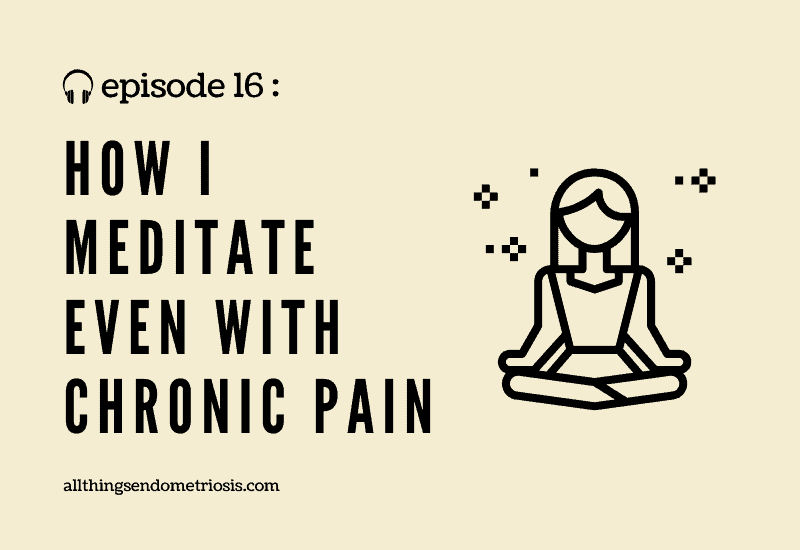
Meditation helps me a great deal in handling my chronic pain. In today’s podcast, I share my three-step meditation process. Listen here to know more, but if you can’t have a listen, then you can read what I’ve said too:
How I Meditate Even With Chronic Pain
“Hi, I’m Shruti and this is my podcast space where I speak about life lessons, chronic conditions, mental and physical health tips and experiences.
Meditation can be such a daunting word.
It’s even more daunting when you see that there are so many different types of meditation!
Before I go on – please consult a doctor before giving meditation a go especially if you have a health issue. I say this because I’m not a medical professional and all of us have our own challenges so it’s best we’re all careful.
And also… a text version of this podcast, it’s available on my website allthingsendometriosis.com
Now, I don’t want to complicate things in this podcast by discussing all the various types of meditation out there because at the end of the day, the point of meditation is to help create stability, calm and clarity which helps with mental, physical and emotional health.
In meditation, a seated position, with legs folded and an upright spine is what’s mainly encouraged but if you have chronic pain, a disability or are dealing with mental or emotional distress then it may not be comfortable to sit like that or you may not be able to mentally pull yourself up and do this, so does that mean you can’t meditate?
I believe we still can… because I too am not always able to follow this teaching so I don’t pressurise myself to do it, but I still want to improve my mental and physical health through meditation.
Which is why, if I am in pain and I am lying down, then I won’t suddenly sit up and fold my legs – I’ll stay how I am and do everything I’m about to explain to help me meditate effectively.
So here’s my three-step meditation process…
Number 1. Get in a comfortable position
– like I said, this could be lying down, seated on a chair, legs folded… any way in which you’re comfortable. Personally, I’m either seated or lying down. Sometimes I may even be curled up in bed but I start the process and eventually as my body relaxes, I’m able to lie on my back and get my spine to be straight.
So to make life easier in explaining, let’s stick with lying down straight, facing the ceiling, hands either side of the body and eyes closed
Next…
Number 2. Deep breathing
– I focus on my breath, breathing slowly, and deeply.
When I say deeply, I mean that when I breathe in, I slowly fill up my stomach with oxygen. My chest doesn’t move much, just my stomach.
I count to five while breathing in…
Then I breathe out SLOWLY, again counting to five.
So let’s do this….
Let’s all breathe in, filling up the stomach on the count of one and keep breathing in slowly till five, then we’ll breathe out from five to one.
Let’s begin… breathe in first… one – two – three – four – five
without holding your breath – breathe out – five – four – three – two – one
One more time…
breathe in: one – two – three – four – five
breathe out: five – four – three – two – oneNow I hope you followed along… or maybe just give it a go a little later on.
So what’s brilliant about deep breathing is that it improves the flow of oxygen around the body, gets the diaphragm working, stabilises blood pressure and is known to reduce stress.
Another thing about deep breathing is that even when you’re not meditating, you can, discreetly breath deeply and help yourself.
A quick recap… in case I’ve lost you…
You’re in a comfortable position with your eyes closed, and are breathing deeply.
So now you should find that with each deep breath your body and mind are relaxing. Your body will start to sink in as each muscle relaxes.
Stay focussed on your deep breathing and allow your body to relax. You allowing this to happen is the most important part of the process.
For some this may not happen easily, and if you’re one of those people, it’s okay – it’ll come with practice as most things do.
Next…
Number 3. Letting Thoughts Come and Go
You’ll find that you’ll get multiple ideas, memories, things to do all popping up in your head at that time – even really random thoughts will come to intrude.
What you should do is let them come and go.
What you should not do is engage with these thoughts – don’t converse with them. Just observe them come and go.
You need to just stay focussed on your deep breathing – inhaling and exhaling slooowwwllllyyy!
As a beginner aim to do this for 5 minutes everyday until you feel you can do it for 7 minutes and then 10 minutes.
Some people like to use alarms to let them know when their time is up or apps that play calm sounds for those 5 minutes.
I do neither – I’m okay to go over my 5 minutes – I don’t want to break my flow with sound interrupting what could possibly be a really nice meditation session.
But what about days when the stress, sadness, pain is all really high – what to do then?
On days when I need extra help, while meditating, I imagine myself to be sitting and meditating by a beautiful river stream breathing in fresh, crisp, clean air surrounded by the green of nature. Somedays I even hear a small waterfall.
Mentally taking myself to a soothing place helps to reduce my troubles, whether that’s pain, anxiety or anything else.
Again, I make sure I’m not engaging with that imaginary environment – I’m just placing myself in that space.
Many end up feeling sleepy during meditation – there are various reasons for this, but as someone with chronic pain, I can tell you why I get sleepy.
When I’m in pain, all tensed up dealing with a lack of or poor sleep, then meditation helps to relax every part of my body so it’s no surprise that sleepiness happens and I don’t mind that because it helps me with my pain management and provides major assistance in helping my mental and emotional health.
If you have no issues – mental, physical or emotional then you should try to avoid meditating after a heavy meal which can make you sleepy and may make you fall asleep.
Now as this podcast comes to a close, I wish to share one really important benefit of meditating.
Imagine that your mind is the ocean.
Imagine that hundreds of pebbles and stones are being thrown in that ocean.
Will you know which stone or pebble caused which ripple?
Nope, not possible.
Now imagine that each pebble or stone was a representation of a thought or an idea.
What if you have multiple thoughts going on in the ocean of your mind all at the same time – will you know which thought or idea is worthy of pursuing?
When you meditate, the purpose is to calm your mind and as you stop engaging with your thoughts and your thoughts reduce, you’ll eventually, over time be able to see that one special pebble and its ripple effects which you might be missing out on when you have a hundred thoughts running through your head.
Give these three simple steps a go – but as I said in the beginning please consult a doctor beforehand especially if you have health issues.
I’ve come to the end of today’s podcast – I would love to hear your thoughts on this topic – maybe you could share your meditation techniques and your experiences? You can message me on my Instagram handle @footprintsnoboundaries or you can email me on [email protected].
Take care everyone – wishing you a calm, peaceful time ahead… b-byeee!”
Read Here For:
- How To Work From Home if You Have a Chronic Illness
- Podcast Ep 8: Forcing Yourself to be Positive?
- How to Self-Isolate & Have a Life: Productive Tips from a Chronic Patient
I’d love to know what you thought of today’s podcast. Please do share your thoughts in the comments section below…
Previous: Podcast Episode 15 – Why is Curiosity Important for Success?
Up Next: Podcast Episode 17 – How to Create Health Goals & Stick to Them!
(text version will be posted next Sunday, but if you would like to hear it on Spotify, then you can here)
If you’re a social media person, then you can follow me on Instagram, Twitter, Facebook or Pinterest.
~~~~~~~~~~~
Disclaimer: I am not a medical professional. I am a patient and have created this platform to share my experiences. This is all purely informative and in no way am I providing medical advice. Please consult a medical professional.


I’ve always felt that I had to sit up straight but it really makes my back hurt. So it’s nice to read that lying down is good for us with chronic illness too! Whatever works best for each person I think.
Thanks for these easy to follow tips. Meditation really is a lot simpler than I think it is haha. I’ll need to try this out 🙂
I’ve learned that meditation (and mindfulness) are not as complex as people make it out to be. It’s not about becoming blank; in fact, that’s not how people are. It’s about bringing yourself back on to the focus point (and that in itself is like a pushup for concentration.) That to me is so freeing and encouraging.
I found meditation difficult in the beginning due to pain- pain seemed to intrude a Lot. But now i really value it a lot. Different kinds and sometimes just relaxation breathing if that is all I can do. Either way, I do it every single day and consider it an important part of my pain management.